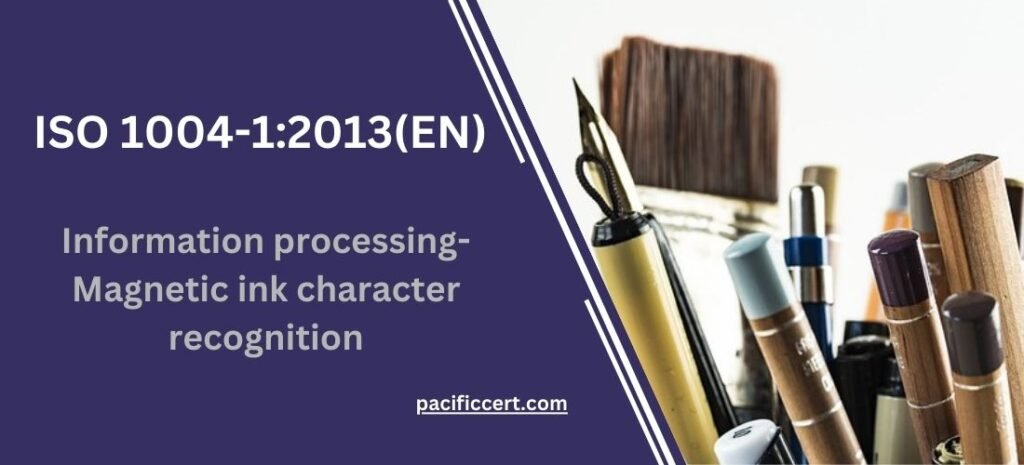
What is ISO 1004-1:2013 Information processing-Magnetic ink character recognition?
ISO 1004-1:2013 Information processing outlines the specifications for the E13B font used in Magnetic Ink Character Recognition (MICR) technology. MICR is commonly used in the banking industry for the automated processing of checks and other financial documents. The E13B font is a specific set of characters that are printed at the bottom of checks and other negotiable instruments, and it is designed to be easily read by both humans and specialized MICR readers.
The ISO 1004-1:2013 standard provides detailed guidelines on various aspects of the E13B font, including:
- Character Dimensions: The standard specifies the exact dimensions for each character in the E13B font set, including height, width, and spacing.
- Ink Properties: The standard outlines the type of magnetic ink to be used, its magnetic properties, and how it should be applied to ensure accurate and efficient reading by MICR devices.
- Print Quality: Parameters such as ink spread, voids, and signal strength are defined to ensure that the printed characters meet the necessary quality criteria for machine readability.
- Error Tolerance: The standard sets acceptable levels of deviation or error in the printed characters, which is crucial for ensuring that the MICR technology functions correctly even if minor printing imperfections occur.
- Test Procedures: Methods for testing the printed characters against the standard’s specifications are also included, ensuring that financial institutions and other users can verify compliance.
The importance of adhering to ISO 1004-1:2013 cannot be overstated, especially for financial institutions that rely on the quick and accurate processing of a large volume of checks and other documents. Non-compliance could lead to errors in financial transactions, increased processing times, and additional costs for manual intervention.
In summary, ISO 1004-1:2013 is a critical standard that governs the print specifications for the E13B font used in MICR technology. It ensures that financial documents can be processed efficiently and accurately, thereby maintaining the integrity of financial systems.
What are the requirements for ISO 1004-1:2013 Information processing?
ISO 1004-1:2013 Information processing forth a comprehensive set of requirements aimed at standardizing the E13B font used in Magnetic Ink Character Recognition (MICR) technology. While I can’t provide the full text of the standard due to copyright reasons, I can outline some of the key areas that the standard typically covers:
Character Dimensions
- Height and Width: The standard specifies the exact dimensions for each character, including its height and width.
- Spacing: Details about the spacing between characters and within each character are provided to ensure uniformity.
Ink Properties
- Magnetic Ink: The type of ink to be used is specified, including its magnetic properties.
- Ink Adhesion: Requirements for how well the ink should adhere to the paper are outlined.
- Ink Density: The standard may specify the density of the ink to ensure it can be read by MICR readers.
Print Quality
- Resolution: The print resolution, often measured in dots per inch (DPI), is specified.
- Signal Strength: Requirements for the magnetic signal strength of the printed characters are outlined.
- Ink Spread and Voids: Parameters for acceptable levels of ink spread and voids in the printed characters are defined.
Error Tolerance
- Deviation: The standard sets acceptable levels of deviation or error in the printed characters.
- Readability: Requirements for how easily the printed characters should be read by MICR devices are specified.
Test Procedures
- Testing Methodology: The standard outlines how to test the printed characters to ensure they meet the specified requirements.
- Quality Control: Guidelines for ongoing quality control and compliance verification are provided.
Documentation
- Record-Keeping: The standard often requires that records be kept of the printing process, ink specifications, and quality control measures.
- Compliance Verification: Documentation proving compliance with the standard may be required.
Adherence to ISO 1004-1:2013 is crucial for organizations, particularly in the financial sector, that rely on MICR technology for processing checks and other financial documents. Non-compliance can result in operational inefficiencies, increased error rates, and additional costs for manual processing.
In summary, ISO 1004-1:2013 is a comprehensive standard that outlines the requirements for the E13B font used in MICR technology. It covers a range of factors from character dimensions and ink properties to print quality and testing procedures, all aimed at ensuring the efficient and accurate processing of financial documents.
What are the benefits of ISO 1004-1:2013?
ISO 1004-1:2013 Information processing offers a range of benefits, particularly for organizations in the financial sector that rely on Magnetic Ink Character Recognition (MICR) technology. Below are some of the key advantages:
Standardization
- Uniformity Across Institutions: The standard ensures that all financial documents using MICR technology are consistent in terms of character dimensions, ink properties, and print quality. This uniformity facilitates interoperability between different banks and financial institutions.
- Global Acceptance: ISO standards are internationally recognized, making it easier for organizations to operate across borders.
Operational Efficiency
- Automated Processing: Compliance with the standard allows for the efficient automated processing of checks and other financial documents, reducing the need for manual intervention.
- Reduced Error Rates: Standardized print specifications minimize the risk of reading errors, thereby reducing the costs associated with corrections and delays.
Quality and Reliability
- High Readability: The standard ensures that the printed characters meet specific quality criteria, making them easily readable by both humans and machines.
- Durability: The ink properties and adhesion requirements ensure that the printed characters are durable and resistant to smudging or fading.
Risk Mitigation
- Fraud Prevention: The use of specialized magnetic ink and specific character dimensions makes it more difficult to forge or alter financial documents.
- Legal Compliance: Adhering to an internationally recognized standard can also provide some level of legal protection in case of disputes.
Cost Savings
- Reduced Operational Costs: Automated, efficient, and error-free processing leads to cost savings.
- Avoidance of Penalties: Compliance with the standard helps in avoiding fines or penalties that might be imposed for non-compliance.
Competitive Advantage
- Market Credibility: Organizations that comply with international standards are often viewed as more credible and reliable by customers and partners.
- Ease of Business: Standardization simplifies business-to-business interactions, making it easier to form new partnerships or enter new markets.
In summary, ISO 1004-1:2013 offers a multitude of benefits ranging from operational efficiency and cost savings to risk mitigation and global standardization. These advantages also make it an essential standard for organizations that rely on MICR technology for the processing of financial documents.
Who needs ISO 1004-1:2013 Information processing?
The ISO 1004-1:2013 standard is primarily targeted at organizations and entities that are involved in the creation, processing, and handling of financial documents that utilize Magnetic Ink Character Recognition (MICR) technology. Here are some of the key stakeholders who would benefit from adopting this standard:
Financial Institutions
- Banks: Banks are perhaps the most obvious users of this standard, as they process a large volume of checks and other financial documents.
- Credit Unions: Similar to banks, credit unions also handle checks and would benefit from standardized MICR characters.
Payment Processors
- Clearing Houses: These entities act as intermediaries between different banks and financial institutions, facilitating the exchange and settlement of checks and other payment instruments.
- Payment Service Providers: Companies that offer payment processing services, including check processing, would need to adhere to this standard to ensure compatibility and efficiency.
Manufacturers and Suppliers
- Printer Manufacturers: Companies that manufacture printers capable of printing MICR characters would need to ensure their products comply with ISO 1004-1:2013.
- Ink Manufacturers: Manufacturers of the specialized magnetic ink used in MICR technology would also benefit from adhering to the standard.
Retail and Corporate Entities
- Large Retailers: Businesses that handle a significant volume of checks, such as supermarkets or large retail chains, may also find it beneficial to comply with this standard.
- Corporations: Large corporations that issue or receive a large number of checks might also adopt this standard to streamline their financial operations.
Regulatory Bodies
- Financial Regulators: Regulatory agencies may require financial institutions under their jurisdiction to comply with international standards like ISO 1004-1:2013.
- Standardization Organizations: Bodies responsible for setting national or industry-specific standards may adopt or adapt ISO 1004-1:2013.
Certification and Auditing Organizations
- Certification Bodies: While Pacific Certifications may not directly certify for ISO 1004-1:2013, understanding its scope and requirements can be beneficial when dealing with related standards.
- Auditors: Financial auditors and compliance officers would need to be familiar with this standard if they are auditing organizations that rely on MICR technology.
Overall, the adoption of ISO 1004-1:2013 ensures that there is a uniform and high-quality standard for the printing of MICR characters, facilitating efficient and secure financial transactions. Given the critical role that such transactions play in the global economy, the standard is of significant importance to a wide range of stakeholders.
Who needs ISO 1004-1:2013?
ISO 1004-1:2013 Information processing is particularly relevant for a variety of organizations and stakeholders involved in the financial sector, as well as those in the manufacturing and regulatory domains. Here’s a breakdown of who might need this standard:
Financial Institutions
- Commercial Banks: These institutions handle a large volume of checks and other negotiable instruments that require standardized MICR characters for efficient processing.
- Credit Unions: Similar to banks, credit unions also process checks and would benefit from the standardization that ISO 1004-1:2013 provides.
Payment Processing Entities
- Clearing Houses: These organizations act as intermediaries for clearing financial transactions between different banks. Standardized MICR characters are crucial for efficient and error-free operations.
- Payment Service Providers: Companies specializing in payment solutions, including check processing, would need to adhere to this standard to ensure compatibility and efficiency.
Manufacturers and Suppliers
- Printer Manufacturers: Companies that produce printers capable of printing MICR characters must ensure their products are compliant with ISO 1004-1:2013 to guarantee their utility in financial transactions.
- Magnetic Ink Manufacturers: The standard specifies the type of magnetic ink to be used, making it important for ink manufacturers to comply.
Retail and Corporate Sector
- Large Retailers: Businesses like supermarkets, which handle a significant volume of checks, would benefit from using standardized MICR characters to streamline their financial transactions.
- Corporations: Large enterprises that issue or receive a high volume of checks may also adopt this standard to enhance the efficiency and security of their financial operations.
Regulatory and Oversight Bodies
- Financial Regulators: Regulatory agencies may mandate or recommend the use of ISO standards like ISO 1004-1:2013 to ensure uniformity and reliability in financial transactions.
- Standardization Organizations: National or industry-specific bodies may adopt or adapt ISO 1004-1:2013 as part of their own set of standards.
Auditing and Certification Organizations
- Auditors: Financial auditors and compliance officers should be familiar with this standard if they are responsible for auditing organizations that rely on MICR technology.
- Certification Bodies: While Pacific Certifications may not directly issue certifications for ISO 1004-1:2013, understanding its scope and requirements can be beneficial when dealing with related standards, such as ISO 27001 for information security.
In summary, ISO 1004-1:2013 is a critical standard for a wide range of stakeholders involved in the creation, processing, and regulation of financial documents that utilize MICR technology. Its adoption ensures uniformity, efficiency, and security in financial transactions, making it indispensable for these entities.
At last, Pacific Certifications is accredited by ABIS, you need more support with ISO 1004-1:2013 Information processing, please contact us at +91-8595603096 or support@pacificcert.com
Read About: ISO/IEC 27011:2016-Security techniques







